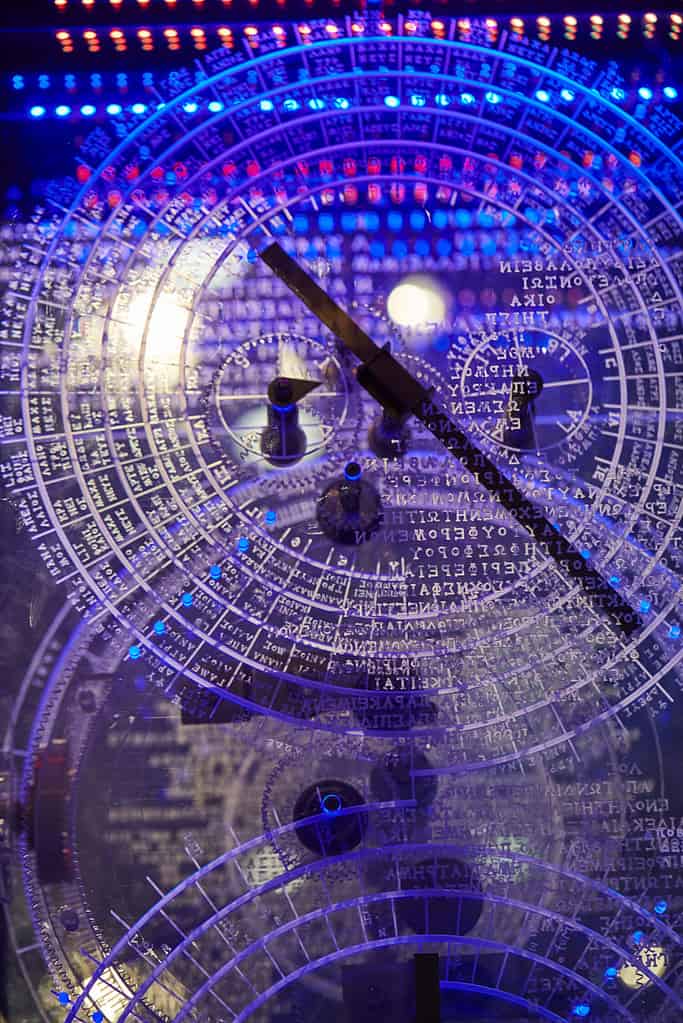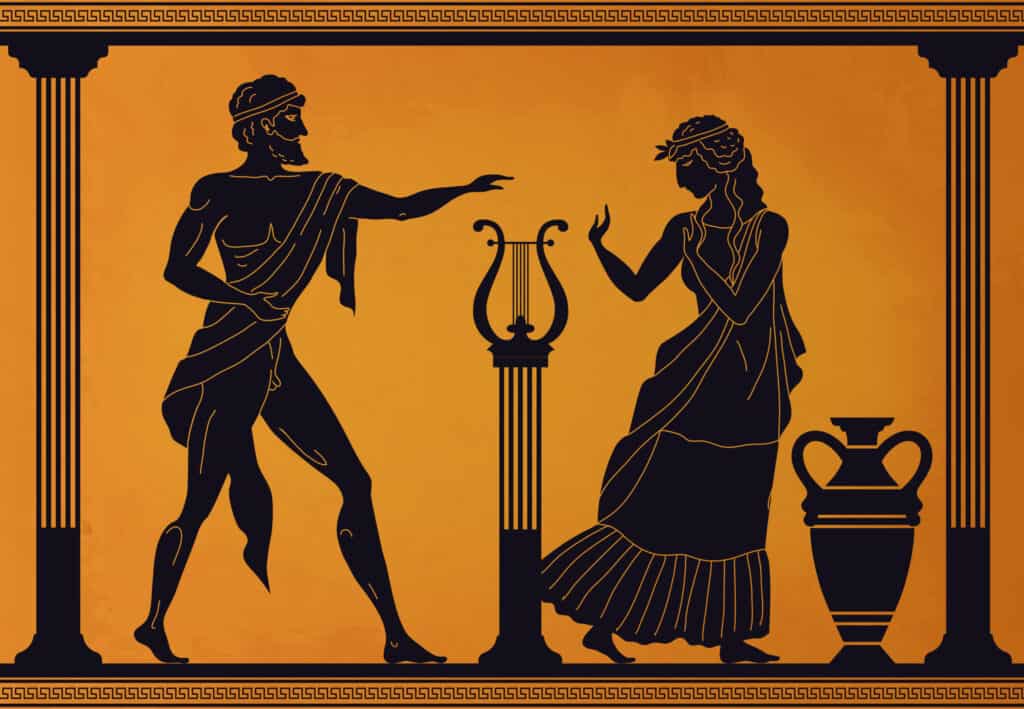Archaeologists have recently made a significant discovery concerning the enigmatic Antikythera, a fascinating ancient mechanism some believe to be the world’s first computer. On December 22, 178 B.C., this intricate device was activated for the first time, shedding new light on its remarkable capabilities.

The Greek Island of Antiythera, where the ancient device was found.
©Andronos Haris/Shutterstock.com
Initially found in the remains of a Roman-era shipwreck near the Greek island of Antikythera in 1901, the Antikythera mechanism resembles a compact gadget about the size of a shoebox. Gears and dials adorn the mechanism, each embellished with numerous minute inscriptions. This ancient computer had the astonishing ability to predict eclipses and accurately determine the timing of various athletic events, among other functions.

This ancient computer had the astonishing ability to predict eclipses and accurately determine the timing of various athletic events, among other functions.
©DU ZHI XING/Shutterstock.com
Over the years, researchers at the University College London (UCL) have dedicated themselves to painstakingly reconstructing the scattered fragments of the Antikythera mechanism. Their ultimate goal has been to unlock the secrets of its creation and understand how people used it over two millennia ago. Despite their efforts, many intriguing questions remain unanswered: Who crafted this remarkable device?
Who Invented the Antikythera Computer?
According to a group of researchers from University College London (UCL), the ingenious design of the intricate mechanism, comprising a complex network of gears that computed and displayed the celestial movements of stars, is attributed to none other than the esteemed ancient Greek mathematician, Archimedes.
While scientists have yet to uncover definitive evidence to confirm his authorship of humanity’s inaugural computer, mathematician and filmmaker Tony Freeth, leading the UCL Research Team along with Greek archaeometallurgist Myrto Georgakopoulou and Aris Dakanalis, strongly advocates the belief that Archimedes himself stands as the mastermind behind this remarkably sophisticated creation.

The Design of the intricate mechanism, comprising a complex network of gears that computed and displayed the celestial movements of stars, is attributed to the esteemed ancient Greek mathematician Archimedes.
©DU ZHI XING/Shutterstock.com
Who is Archimedes?
Archimedes was an ancient Greek mathematician, physicist, engineer, and inventor who lived in Syracuse, Sicily (approximately 287 BC – 212 BC). Researchers regard him as one of the greatest mathematicians and scientists of antiquity and significantly contributed to various fields of knowledge.
People know Archimedes for his work in mathematics, where he made pioneering advancements in geometry and calculus. People credit him with discovering the principles of buoyancy, known as Archimedes’ principle, which explains why objects float or sink in a fluid. This discovery famously led him to exclaim “Eureka!” (meaning “I have found it!”) when he solved a problem while stepping into a bath.
Among his other notable achievements, Archimedes calculated an approximation of pi, developed methods to determine the area and volume of various shapes, and devised the concept of the lever and compound pulleys, showcasing his exceptional engineering prowess.
In addition to his mathematical and scientific accomplishments, people know Archimedes as an inventor credited with designing innovative machines such as the Archimedes screw, a device to lift water, and various war machines to defend his hometown of Syracuse during the Roman siege.
How Does the Antikythera Mechanism Work?
Until scientists discover a fully intact and well-preserved device similar to the Antikythera mechanism, our understanding of its exact functioning remains speculative. However, archaeologists are adept at deciphering ancient mysteries, and a recent study published in the journal Nature, co-authored by Freeth, presents a new reconstruction of the device, incorporating all available evidence.
One standard theory suggests that the mechanism operates by a missing hand crank, which would connect to the main gear through a crown gear. Turning the crank would shift the date indicator on the front dial to the appropriate day on the calendar.

With the device in proper working order, the crank would move the date marker about 78 days with each full rotation, enabling the simultaneous determination of the
Sun’s
and Moon’s positions, lunar phases, eclipse timings, calendar cycles, and potentially the positions of planets.
©DU ZHI XING/Shutterstock.com
Another approach involves using the Babylonian “ephemeris tables” to identify the various calendar cycles indicated by the back’s calendar cycle indicators, as most calendar cycles do not synchronize with the year.
With the device in proper working order, the crank would move the date marker about 78 days with each full rotation, enabling the simultaneous determination of the Sun’s and Moon’s positions, lunar phases, eclipse timings, calendar cycles, and potentially the positions of planets.
The front dial displayed the Sun and Moon’s positions and a half-silvered ball indicating lunar phases. The operator also needed to observe the position of the spiral dial pointers on the large dials on the back. These dials completed four and five rotations, and a “follower” mechanism tracked their positions by following spiral incisions on the metal.
The Upper Dial
The upper dial showed the Metonic cycle, 19 years with 235 synodic months, used for regulating calendars. A smaller four-year dial indicated the timing of the Panhellenic games, including the ancient Olympics. The lower dial featured symbols to predict months with a likelihood of solar or lunar eclipses.
In summary, the Antikythera mechanism’s precise functioning continues to elude us, but with ongoing research and careful analysis, we are getting closer to unlocking its fascinating secrets.
Different Aspects of the Antikythera Mechanism
Gears and Dials: The mechanism consists of a complex system of interlocking gears and dials. These gears are responsible for performing various calculations and displaying astronomical information.
Calendar System: The inventor designed the mechanism to track and predict astronomical events based on a calendar system. It could display the positions of celestial bodies, such as the sun, moon, and planets, and predict eclipses.
Differential Gear: One of the most impressive features of the Antikythera mechanism is its use of differential gears. This gear system allows the agent to account for celestial bodies’ varying speeds and orbits. It is a sophisticated mechanical technique seen again in the 16th century in Europe.
Eclipse Prediction: The Antikythera mechanism could predict both solar and lunar eclipses. By turning a hand crank, the user could observe how the tool represented the positions of the sun and moon over time, allowing them to foresee eclipses.
Zodiac Display: The front dial of the mechanism displays the zodiac signs and the positions of the sun and moon in the zodiac throughout the year.
Moon Phases: Another dial represented the moon’s phases, showing its position during different periods.
Planetary Movements: The mechanism also accounted for the movement of the planets Mercury and Venus.
The exact method of inputting data into the Antikythera mechanism is still unclear, and some aspects of its design and operation remain subjects of ongoing research and speculation. However, this ancient device was a remarkable feat of engineering and astronomy, offering valuable insights into the scientific knowledge and technological achievements of the ancient Greeks.
Reconstruction of the model
The UCL researchers team has invested substantial effort into reconstructing a functional replica of a remarkable 2,000-year-old mechanism. Eighty-two bronze fragments on the device miraculously survived centuries submerged underwater. Over the past century, people attempted numerous times to reconcile astrological and mechanical patterns, aiming to reveal the ancient Greek Cosmos with its Sun, Moon, and five known planets of antiquity.
The initial computer comprised over 30 bronze gearwheels intricately connected to dials and pointers and operated using a crank handle. Deciphering engravings on the front and back of the original device, housed within a wooden case, was an essential task for the researchers. These inscriptions provided specific events and predictions about Mercury, Venus, Mars, Jupiter, and Saturn’s behaviors. The following challenge involved a lot of calculations, focusing on “period relations,” or the relationships between planets in their orbits. The objective was to calibrate the geared mechanism accurately.
The research team has successfully constructed a working model replicating this ancient computer’s functions through the meticulous study of ancient astronomical records, complex mathematics, and precise engineering of parts. Nevertheless, there remains uncertainty concerning whether the ancient Greeks possessed the technical capability to create the nested, hollow axles used in the current experiment, enabling the precise and interlocking rotation of the celestial bodies.
In summary, the researchers’ diligent efforts have led to a functional recreation of this extraordinary ancient mechanism. Yet, questions persist about the ancient Greeks’ engineering prowess and ability to produce such technologically advanced and sophisticated hardware.
Fun Facts about Ancient Greece

Ancient Greece was home to many renowned philosophers, including Socrates, Plato, and Aristotle, who significantly contributed to Western philosophy. They laid the foundation for many modern philosophical ideas.
©Richard Panasevich/Shutterstock.com
Ancient Greece is a treasure trove of fascinating and fun facts. Here are some interesting tidbits about this extraordinary civilization:
Birthplace of Democracy: Ancient Greece is often considered the birthplace of democracy. The city-state of Athens is known for its democratic system of government. Citizens participated in decision-making and had the right to vote.
The ancient Olympic Games were first held in Olympia in 776 BCE and were significant sporting events that brought together athletes from various Greek city-states. Each state competed in various athletic competitions.
Famous Philosophers: Ancient Greece was home to many renowned philosophers, including Socrates, Plato, and Aristotle. They significantly contributed to Western philosophy and laid the foundation for many modern philosophical ideas.
More Fun Facts
The Greek Pantheon: The Greeks had a rich, colorful pantheon of gods and goddesses. This included Zeus, Hera, Athena, Apollo, and Aphrodite, each associated with different aspects of life and Nature.
Theater and Drama: Greek theater and drama were highly developed art forms. They gave birth to famous playwrights like Aeschylus, Sophocles, Euripides, and Aristophanes. They crafted enduring plays that are still performed and studied today.
The Parthenon: The Parthenon is located on the Acropolis in Athens. It is one of the most iconic symbols of ancient Greek architecture. The Greeks built the temple to dedicate it to the goddess Athena.
The Trojan War: The Trojan War, a legendary conflict between the city of Troy and the Greeks, is a famous tale immortalized in Homer’s epic poems, the Iliad, and the Odyssey.
The Delphic Oracle: The Oracle of Delphi was a renowned religious institution in ancient Greece, where people sought guidance and prophecies from the priestess known as the Pythia.
The Alphabet: The Greek alphabet is the basis for the Latin alphabet used in many languages today. It is among history’s most influential writing systems.
Ingenious Inventions: Ancient Greeks were responsible for several ingenious inventions. The watermill, the odometer, the catapult, and the Antikythera mechanism, are considered one of the earliest known analog computers.
Other Notable Inventions from Ancient Greece

Ancient Greeks can credit themselves with creating and developing theatre as an art form. They performed plays in outdoor arenas, and notable playwrights like Aeschylus, Sophocles, and Euripides wrote enduring tragedies and comedies.
©Sven Hansche/Shutterstock.com
Ancient Greece was a hub of innovation and creativity, and its inventors significantly contributed to various fields. Here are some other notable inventions and innovations from ancient Greece:
Pythagorean Theorem: Developed by the mathematician Pythagoras and his followers. This fundamental theorem in geometry relates to the sides of a right-angled triangle. It states that the square of the hypotenuse equals the sum of the courts of the other two sides.
Steam Engine: Greeks did not use it for practical purposes. The ancient Greek engineer Hero of Alexandria created a rudimentary steam-powered device known as the Aeolipile or Hero’s Engine. It demonstrated the principles of steam propulsion and rotation.
Water Clock (Clepsydra): Ancient Greeks used water clocks to measure time. These clocks relied on the regulated water flow from one container to another. It marked the passage of time based on the water level.
Odometer: Invented by Archimedes, the odometer was a device used to measure distances traveled. It employed a series of gears mounted on a wheeled vehicle.
Astrolabe: The astrolabe was an instrument for solving problems related to timekeeping, astronomy, and navigation. It enabled sailors and astronomers to measure the position of celestial objects and determine latitude.
More Inventions
Central Heating System (Hypocaust): The ancient Greeks and Romans used a hypocaust system to heat buildings. It involved an underfloor heating system where hot air from a furnace passed through pipes or cavities beneath the floor. This warmed the rooms above.
Catapult: The Greeks developed various types of catapults, including the ballista and the torsion-powered mangonel, for military purposes. The Greeks used these siege engines to launch projectiles at enemy fortifications.
Trireme: The trireme was an ancient Greek warship with three rows of oars on each side. It was a powerful vessel crucial in naval warfare during the Classical period.
Theatre: Ancient Greeks can credit themselves with creating and developing theatre as an art form. They performed plays in outdoor arenas, and notable playwrights like Aeschylus, Sophocles, and Euripides wrote enduring tragedies and comedies.
Screw Press: The screw press was an essential tool for pressing olives to extract oil. People used it in ancient Greece for agricultural and culinary purposes.
These inventions and discoveries exemplify ancient Greece’s intellectual and technological achievements, which continue to influence and inspire modern civilization.
Where was Ancient Greece exactly?
People can locate Ancient Greece in southeastern Europe. It sits on the Balkan Peninsula and the surrounding islands in the Aegean Sea. It included regions that are part of present-day Greece, Turkey, Bulgaria, and other neighboring countries.

An antique scene of Ancient Greece.
©SpicyTruffel/Shutterstock.com
Golden Age of Ancient Greece
The Golden Age of Ancient Greece is generally associated with the Classical period, mainly the 5th century BCE. People consider this era the pinnacle of Greek civilization, marked by significant cultural, intellectual, and artistic achievements. The Golden Age is synonymous with the rise of Athens as a dominant city-state. It flourished under the leadership of Pericles. During this time, Athens became a center of art, philosophy, drama, and democratic governance. It left a lasting impact on Western civilization.
The 5th century BCE witnessed the construction of iconic structures. The Parthenon on the Acropolis, the development of famous philosophical schools, including those of Socrates, Plato, and Aristotle, and the creation of timeless dramatic works by playwrights like Aeschylus, Sophocles, and Euripides. The Golden Age of Ancient Greece was a time of unparalleled intellectual and artistic creativity. It left a rich and enduring legacy that inspires and influences the modern world.
The photo featured at the top of this post is © DU ZHI XING/Shutterstock.com
Thank you for reading! Have some feedback for us? Contact the AZ Animals editorial team.







